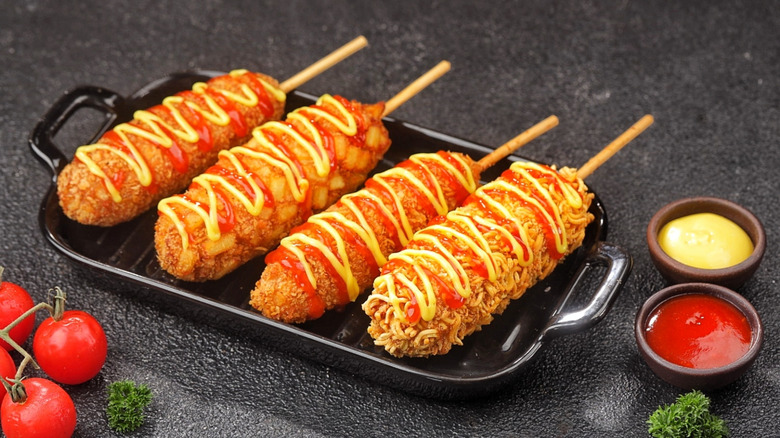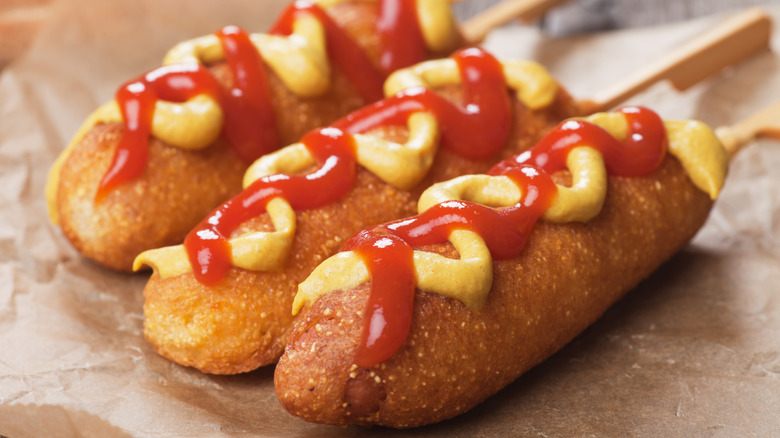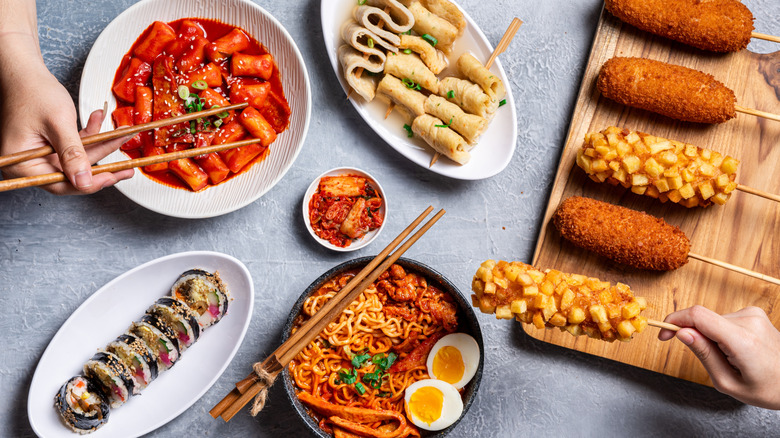Korean Vs American Corn Dogs: What's The Difference?
The corn dog needs no introduction — it evokes nostalgic images of Americana: summer days spent at state fairs, amusement parks, and baseball games. But corn dogs aren't only enjoyed in America. All over the world, many countries have their own unique takes on this deep-fried favorite — and the Korean corn dog is perhaps the most famous. With the rise of the Korean Wave in the 1990s, the USA was introduced to a wide range of cultural exports which have since become everyday staples — from K-pop and Korean Skincare to K-dramas, and of course, the Korean corn dog. Today, they're widely in demand, with specialized chains like Two Hands Corn Dogs boasting over 70 locations across the States.
But Korean corn dogs have been around long before they captured the hearts of America. In fact, the Korean and American variations share similar roots shaped by history. The American corn dog came first, and has quite dubious origins, with some attributing its emergence to German immigrants in Texas (whose early versions lacked the iconic stick), and they're more formally attributed to a 1929 patent describing a typical modern corn dog.
Korean corn dogs, meanwhile, are believed to have been introduced in the 1950s by American soldiers during the Korean War. This era also saw the emergence of several popular American foods introduced to Korea, which were later reinvented with local flair – Korean fried chicken and Budae Jjigae, aka army base stew (which contains Spam), are other notable examples of these wartime culinary exchanges.
What is an American corn dog?
An important distinction between American and Korean corn dogs lies in the batter. Both variations feature a hot dog coated in a batter and deep-fried, but the similarities pretty much end there. The type of batter used is an interesting reflection of both regional preferences and the availability of local ingredients in each country. American corn dogs typically go for a cornmeal batter, which gives them a slightly sweet, earthy flavor and a distinctive, crispy coating. They're similarly simple when it comes to the dog itself, usually just containing a classic beef or pork frankfurter (as opposed to the slightly more inventive combos found in Korea).
When it comes to toppings, American corn dogs are, similarly, more minimalist than their Korean counterparts. While you can use whatever toppings your heart desires, they're usually eaten plain or served with classic condiment staples like ketchup, mustard, and sometimes relish. American corn dogs are commonly associated with specific events such as fairs, festivals, amusement parks, and the occasional school lunch (while the Korean version is much more of a casual snack).
What is a Korean Corn dog?
A fun fact about the Korean Corn dog: In Korea, it's simply known as "Gamja-hatdogeu" — literally, potato hot dog. In the 1980s, corn dogs gained widespread popularity in Korea as a street food and are now a common everyday snack. You're likely to find them at street food markets, food stalls, and even convenience stores.
No two Korean corn dogs are the same. Korean versions offer a wide range of unique fillings. Mozzarella, fish cakes, or even half-sausage, half-cheese combos are all popular and widely available options. These fillings create a fun and customizable mixture of textures and flavors, giving Korean corn dogs a unique identity with some extra pizzazz. The outer coating also adds to this experience, with panko breadcrumbs, golden potato cubes, and dried, crushed ramen being added to the batter for extra crunch and visual appeal.
While American corn dog batter is made with, well, corn, Korean corn dogs tend to use wheat or rice flour, which gives them a more neutral flavor, with a lighter, chewier bite.
Korean corn dogs are famous for their wide variety of bold toppings, which are reflective of Korea's world-famous and vibrant street-food scene. They're often dusted with sugar and drizzled with sweet, spicy, and savory sauces. Common condiments include spicy mayo, crunchy mustard, and gochujang. This unique mix of flavors makes Korean corn dogs more eclectic, flavorful, and customizable than their American counterparts.



